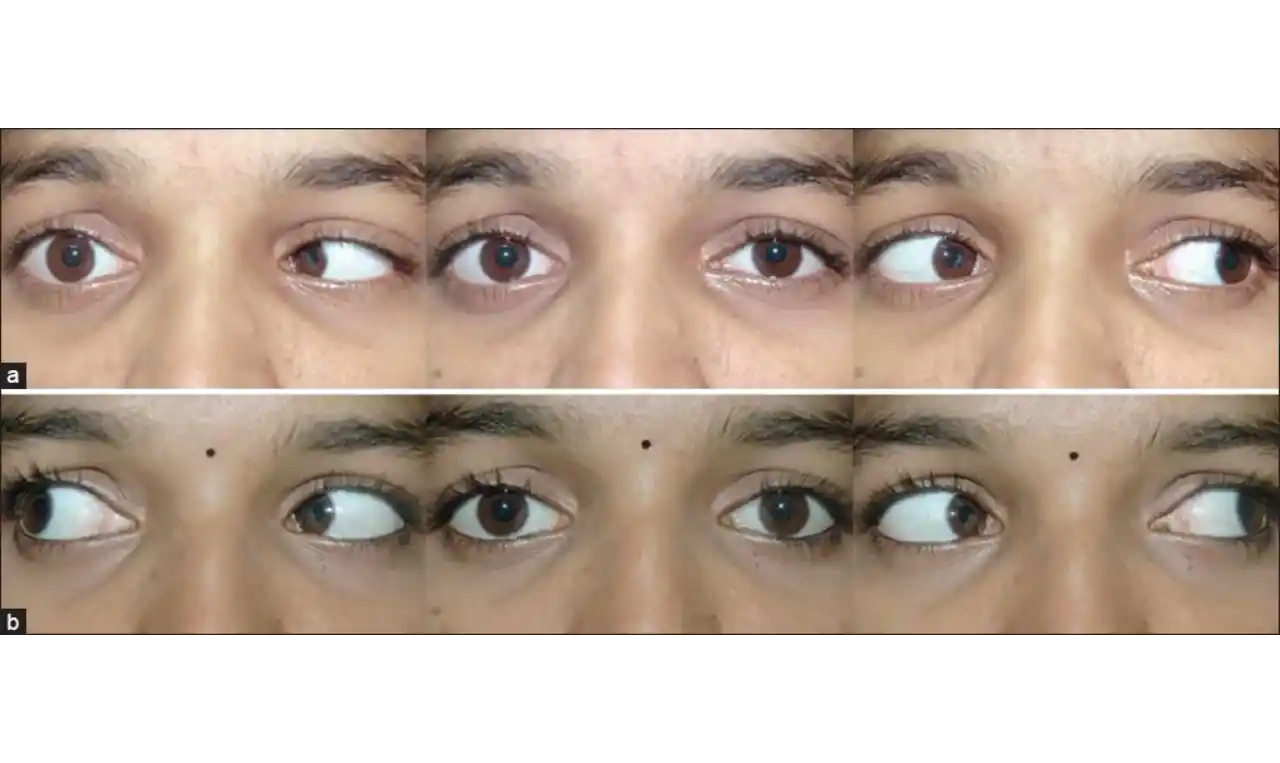
What is Abducens Nerve Palsy?
Abducens (or Abducent) nerve Palsy, also known as Cranial Nerve Six Palsy (CN VI), is a common neuro-ophthalmic disorder. CN VI has a long intracranial course, making it susceptible to multiple etiologies. This condition can be unilateral or bilateral.
CN VI is a purely motor nerve that innervates the ipsilateral (same side) lateral rectus muscle of the eye, controlling the abduction (outward movement) of the eyeball. This nerve has the longest intracranial course among all cranial nerves. Isolated palsy of this nerve is rare; often, the seventh (CN VII or facial) and eighth (CN VIII or vestibulocochlear) cranial nerves are also affected, indicating a central cause.
In children, CN VI palsy is often due to a tumor, while in older adults, it is usually caused by vasculopathy leading to ischemia. CN VI palsy can present with a ‘false localizing sign,’ where the actual causative issue or tumor may be located elsewhere, or may not be detectable at all. Raised intracranial pressure can also stretch CN VI, potentially compressing its vascular supply.
The sixth cranial nerve is the most commonly affected motor nerve to the eye in adults.
Abducens Nerve Palsy Symptoms
- Diplopia (double vision), worse in the field of palsy
- Esotropia (inward deviation of the eyeball)
- Head turn towards the affected side to maintain fusion and avoid diplopia in mild cases
- Closure of one eye voluntarily to avoid diplopia in severe unilateral palsy or bilateral involvement
Abducens Nerve Palsy Causes
Common Aetiologies in Children
- Congenital
- Raised intracranial pressure
- Trauma
- Tumor
- Infection
Additional Aetiologies in Adults
- Diabetes mellitus
- Hypertension
Other Conditions
- Disorders of the subarachnoid space
- Cavernous sinus syndrome
- Orbital apex syndrome
CN VI nerve palsy can be a rare initial presentation in multiple sclerosis. Recurrence of CN VI palsy can occur multiple times and has been reported in both adults and children. An inherited autosomal dominant condition may cause familial recurrent CN VI palsy along with involvement of the seventh (facial) nerve.
Clinical Presentation
Patients with CN VI paresis present with esotropia (inward deviation) of the affected eye. Outward movement beyond the primary position or midline is lost or reduced. Patients with partial or mild palsy adopt a posture with a head turn towards the affected side to minimize diplopia by keeping the affected eye adducted (inward movement). Severe cases may shut the eye or cover it to avoid diplopia.
Presentation varies based on the etiology:
Congenital CN VI Palsy
Congenital CN VI palsy may present with congenital esotropia, which typically occurs about six to eight weeks after birth. Most cases without peripheral misdirection of nerves are transient and likely due to perinatal trauma. There are two types of transient CN VI palsy:
- Neonatal esotropia with an obvious unilateral abduction deficit
- Neonatal esotropia with no obvious unilateral abduction deficit
Acquired CN VI Palsy
Acquired CN VI palsy can result from various etiologies. Benign recurrent CN VI palsy in children may occur after a benign acute viral illness or immunization. This condition presents with acute onset and is associated with restricted abduction.
Patients with vasculopathy typically present with sudden onset, painless horizontal diplopia. These patients usually experience spontaneous and complete resolution within three to six months.
Patients with raised intracranial pressure (ICP) may present with unilateral or bilateral symptoms, including headache, visual obscuration, or profound loss of vision.
Intracavernous carotid artery dissection or aneurysm may produce painful CN VI palsy along with ipsilateral Horner syndrome. Mastoiditis and petrositis complicating chronic otitis media can present with painful CN VI palsy. A tumor in this region may produce a combined trigeminal-abducens-facial nerve syndrome.
CN VI palsy may also be associated with involvement of the seventh or eighth cranial nerves. In unilateral CN VI, four to sixteen prism diopters of hyperdeviation may be present due to vertical strabismus in children, such as dissociated vertical deviation, superior oblique palsy, or physiological hyperphoria.
Differential Diagnosis
- Duane Syndrome: A congenital condition due to misdirected third cranial nerve innervation of the lateral rectus, which may simulate CN VI palsy.
- Möbius Syndrome: A congenital bilateral CN VI nerve palsy along with seventh cranial nerve palsy.
- Wernicke Encephalopathy: Resulting from thiamine depletion, this condition may produce features of inability to abduct eyes similar to bilateral CN VI palsy.
- Myasthenia Gravis: Clinical features and tests can distinguish Myasthenia gravis from CN VI palsy.
- Traumatic Fracture of the Medial Orbital Wall with Medial Rectus Entrapment: This condition may produce restrictive esotropia.
- Dysthyroid Ophthalmopathy: Mainly affecting the medial rectus muscle, this condition may also produce restrictive esotropia.
- Orbital Tumor: May also produce restrictive esotropia.
Treatment and Management
Treatment of CN VI palsy depends on the underlying cause. In cases of congenital CN VI palsy, monitoring and conservative management are often sufficient as many cases resolve spontaneously. For acquired CN VI palsy, addressing the underlying cause, such as managing diabetes or hypertension, can lead to improvement in symptoms.
In cases where a tumor or increased intracranial pressure is identified, surgical intervention may be necessary. For patients with persistent diplopia, prism glasses or eye patches can help manage symptoms. Physical therapy focusing on eye muscle exercises may also be beneficial in some cases.
Overall, the prognosis for CN VI palsy varies based on the etiology and the timeliness of intervention. Early diagnosis and appropriate management are key to improving outcomes and minimizing complications.
Conclusion
Abducens Nerve Palsy is a condition that affects the sixth cranial nerve, leading to issues with eye movement and alignment. While it can be caused by various factors, ranging from congenital issues to acquired conditions like vasculopathy or tumors, understanding the symptoms and seeking timely medical intervention is crucial. With appropriate treatment and management, many patients can achieve significant improvement in their symptoms.
